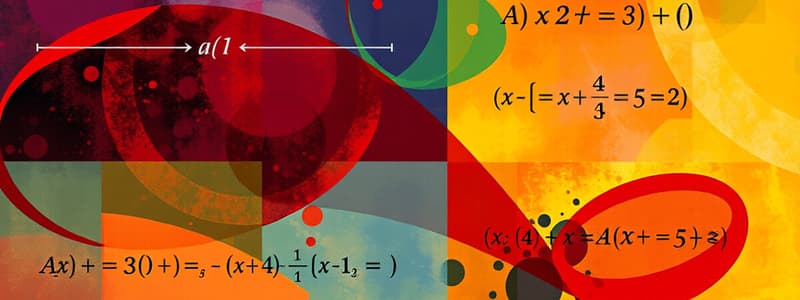Podcast
Questions and Answers
What does the term 'family of graphs' refer to?
What does the term 'family of graphs' refer to?
- Graphs only for linear equations
- A single graph type
- Graphs that display similar characteristics (correct)
- Graphs without any characteristics
What is a parent function?
What is a parent function?
The simplest function of the family
What is the linear equation expressed mathematically?
What is the linear equation expressed mathematically?
f(x)=x
What is the linear domain?
What is the linear domain?
What is the linear x-intercept?
What is the linear x-intercept?
What is the linear range?
What is the linear range?
What is the linear y-intercept?
What is the linear y-intercept?
What is the maximum number of roots/zeros for a linear function?
What is the maximum number of roots/zeros for a linear function?
What does end behavior of a function describe?
What does end behavior of a function describe?
What is the end behavior of a linear function?
What is the end behavior of a linear function?
Is a linear function continuous or discontinuous?
Is a linear function continuous or discontinuous?
What is the absolute value equation mathematically expressed?
What is the absolute value equation mathematically expressed?
What is the absolute value domain?
What is the absolute value domain?
What is the absolute value range?
What is the absolute value range?
What is the absolute value x-intercept?
What is the absolute value x-intercept?
What is the absolute value y-intercept?
What is the absolute value y-intercept?
What is the maximum number of roots/zeros for an absolute value function?
What is the maximum number of roots/zeros for an absolute value function?
Is the absolute value function continuous or discontinuous?
Is the absolute value function continuous or discontinuous?
What is the end behavior of an absolute value function?
What is the end behavior of an absolute value function?
What is the quadratic equation expressed mathematically?
What is the quadratic equation expressed mathematically?
What is the quadratic domain?
What is the quadratic domain?
What is the quadratic range?
What is the quadratic range?
What is the quadratic x-intercept?
What is the quadratic x-intercept?
What is the quadratic y-intercept?
What is the quadratic y-intercept?
What is the maximum number of roots/zeros for a quadratic function?
What is the maximum number of roots/zeros for a quadratic function?
What is the end behavior of a quadratic function?
What is the end behavior of a quadratic function?
Is the quadratic function continuous or discontinuous?
Is the quadratic function continuous or discontinuous?
What is the cubic equation in mathematical terms?
What is the cubic equation in mathematical terms?
What is the cubic domain?
What is the cubic domain?
What is the cubic range?
What is the cubic range?
What is the cubic x-intercept?
What is the cubic x-intercept?
What is the cubic y-intercept?
What is the cubic y-intercept?
What is the maximum number of roots/zeros for a cubic function?
What is the maximum number of roots/zeros for a cubic function?
What is the end behavior of a cubic function?
What is the end behavior of a cubic function?
Is the cubic function continuous or discontinuous?
Is the cubic function continuous or discontinuous?
What are asymptotes?
What are asymptotes?
What is the square root equation expressed mathematically?
What is the square root equation expressed mathematically?
What is the square root domain?
What is the square root domain?
What is the square root range?
What is the square root range?
What is the square root x-intercept?
What is the square root x-intercept?
What is the square root y-intercept?
What is the square root y-intercept?
What is the maximum number of roots/zeros for a square root function?
What is the maximum number of roots/zeros for a square root function?
What is the end behavior of a square root function?
What is the end behavior of a square root function?
Is the square root function continuous or discontinuous?
Is the square root function continuous or discontinuous?
What is the cube root equation expressed mathematically?
What is the cube root equation expressed mathematically?
What is the cube root domain?
What is the cube root domain?
What is the cube root range?
What is the cube root range?
What is the cube root x-intercept?
What is the cube root x-intercept?
What is the cube root y-intercept?
What is the cube root y-intercept?
What is the maximum number of roots/zeros for a cube root function?
What is the maximum number of roots/zeros for a cube root function?
Flashcards are hidden until you start studying
Study Notes
Graph Families and Parent Functions
- Family of graphs share similar characteristics and display distinct forms.
- Parent function is the simplest representation within a graph family.
Linear Functions
- Linear equation defined as f(x) = x.
- Domain includes all real numbers.
- X-intercept and Y-intercept both at (0,0).
- Range also consists of all real numbers.
- Maximum number of roots/zeros for linear functions is 1.
- End behavior: As x approaches -∞, f(x) approaches -∞; as x approaches ∞, f(x) approaches ∞.
- Linear functions are continuous without breaks.
Absolute Value Functions
- Absolute value equation as f(x) = |x|.
- Domain includes all real numbers.
- Range includes values where y is greater than or equal to 0.
- X-intercept and Y-intercept both at (0,0).
- Maximum number of roots/zeros for absolute value functions is 2.
- End behavior: As x approaches -∞, f(x) approaches ∞; as x approaches ∞, f(x) also approaches ∞.
- Absolute value functions are continuous.
Quadratic Functions
- Quadratic equation expressed as f(x) = x².
- Domain includes all real numbers.
- Range includes values where y is greater than or equal to 0.
- X-intercept and Y-intercept both at (0,0).
- Maximum number of roots/zeros for quadratic functions is 2.
- End behavior: As x approaches -∞, f(x) approaches ∞; as x approaches ∞, f(x) also approaches ∞.
- Quadratic functions are continuous.
Cubic Functions
- Cubic equation is f(x) = x³.
- Domain includes all real numbers.
- Range also includes all real numbers.
- X-intercept and Y-intercept both at (0,0).
- Maximum number of roots/zeros for cubic functions is 3.
- End behavior: As x approaches -∞, f(x) approaches -∞; as x approaches ∞, f(x) approaches ∞.
- Cubic functions are continuous.
Square Root Functions
- Square root equation as f(x) = √x.
- Domain requires x to be greater than or equal to 0.
- Range includes values where y is greater than or equal to 0.
- X-intercept and Y-intercept both at (0,0).
- Maximum number of roots/zeros for square root functions is 1.
- End behavior: As x approaches 0, f(x) approaches 0; as x approaches ∞, f(x) approaches ∞.
- Square root functions are discontinuous.
Cube Root Functions
- Cube root equation expressed as f(x) = ∛x.
- Domain includes all real numbers.
- Range also includes all real numbers.
- X-intercept and Y-intercept both at (0,0).
- Maximum number of roots/zeros is 1.
- End behavior similar to cubic functions, with f(x) approaching -∞ as x goes to -∞ and ∞ as x goes to ∞.
- Cube root functions are continuous.
Asymptotes
- Describes curves that approach a line or value but never touch it.
Studying That Suits You
Use AI to generate personalized quizzes and flashcards to suit your learning preferences.




